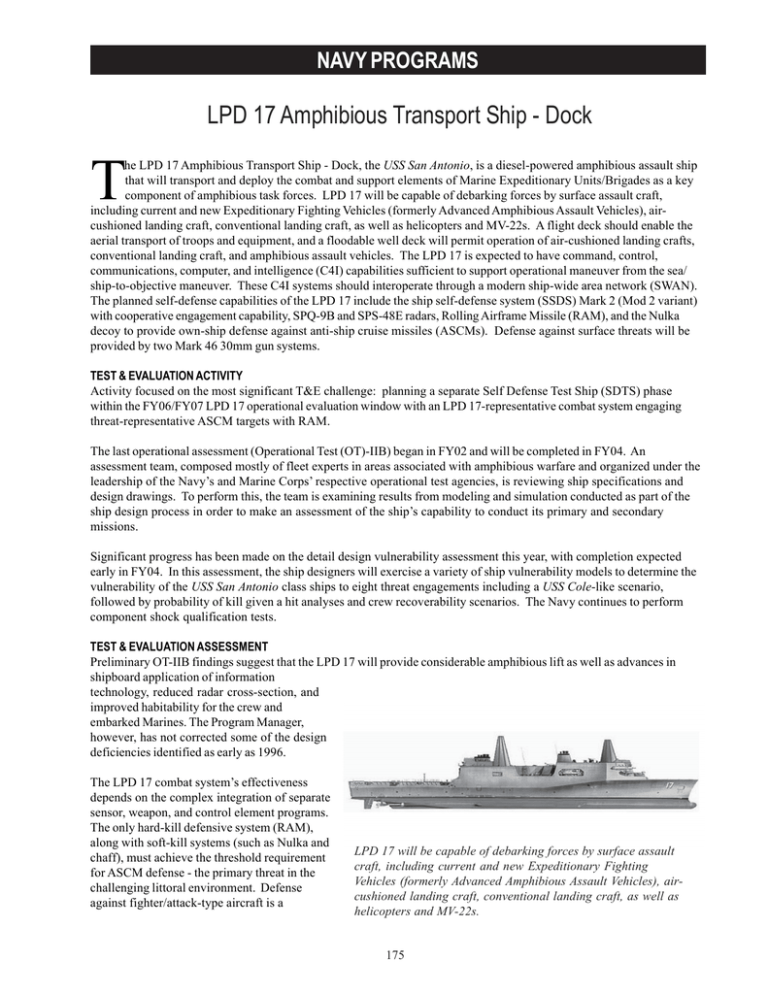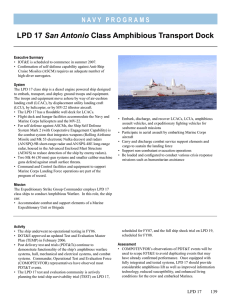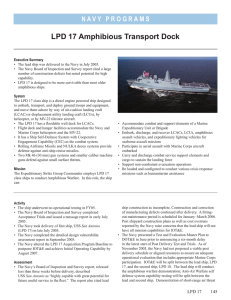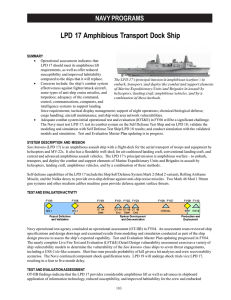T LPD 17 Amphibious Transport Ship - Dock NAVY PROGRAMS
advertisement

NAVY PROGRAMS LPD 17 Amphibious Transport Ship - Dock T he LPD 17 Amphibious Transport Ship - Dock, the USS San Antonio, is a diesel-powered amphibious assault ship that will transport and deploy the combat and support elements of Marine Expeditionary Units/Brigades as a key component of amphibious task forces. LPD 17 will be capable of debarking forces by surface assault craft, including current and new Expeditionary Fighting Vehicles (formerly Advanced Amphibious Assault Vehicles), aircushioned landing craft, conventional landing craft, as well as helicopters and MV-22s. A flight deck should enable the aerial transport of troops and equipment, and a floodable well deck will permit operation of air-cushioned landing crafts, conventional landing craft, and amphibious assault vehicles. The LPD 17 is expected to have command, control, communications, computer, and intelligence (C4I) capabilities sufficient to support operational maneuver from the sea/ ship-to-objective maneuver. These C4I systems should interoperate through a modern ship-wide area network (SWAN). The planned self-defense capabilities of the LPD 17 include the ship self-defense system (SSDS) Mark 2 (Mod 2 variant) with cooperative engagement capability, SPQ-9B and SPS-48E radars, Rolling Airframe Missile (RAM), and the Nulka decoy to provide own-ship defense against anti-ship cruise missiles (ASCMs). Defense against surface threats will be provided by two Mark 46 30mm gun systems. TEST & EVALUATION ACTIVITY Activity focused on the most significant T&E challenge: planning a separate Self Defense Test Ship (SDTS) phase within the FY06/FY07 LPD 17 operational evaluation window with an LPD 17-representative combat system engaging threat-representative ASCM targets with RAM. The last operational assessment (Operational Test (OT)-IIB) began in FY02 and will be completed in FY04. An assessment team, composed mostly of fleet experts in areas associated with amphibious warfare and organized under the leadership of the Navy’s and Marine Corps’ respective operational test agencies, is reviewing ship specifications and design drawings. To perform this, the team is examining results from modeling and simulation conducted as part of the ship design process in order to make an assessment of the ship’s capability to conduct its primary and secondary missions. Significant progress has been made on the detail design vulnerability assessment this year, with completion expected early in FY04. In this assessment, the ship designers will exercise a variety of ship vulnerability models to determine the vulnerability of the USS San Antonio class ships to eight threat engagements including a USS Cole-like scenario, followed by probability of kill given a hit analyses and crew recoverability scenarios. The Navy continues to perform component shock qualification tests. TEST & EVALUATION ASSESSMENT Preliminary OT-IIB findings suggest that the LPD 17 will provide considerable amphibious lift as well as advances in shipboard application of information technology, reduced radar cross-section, and improved habitability for the crew and embarked Marines. The Program Manager, however, has not corrected some of the design deficiencies identified as early as 1996. The LPD 17 combat system’s effectiveness depends on the complex integration of separate sensor, weapon, and control element programs. The only hard-kill defensive system (RAM), along with soft-kill systems (such as Nulka and chaff), must achieve the threshold requirement for ASCM defense - the primary threat in the challenging littoral environment. Defense against fighter/attack-type aircraft is a LPD 17 will be capable of debarking forces by surface assault craft, including current and new Expeditionary Fighting Vehicles (formerly Advanced Amphibious Assault Vehicles), aircushioned landing craft, conventional landing craft, as well as helicopters and MV-22s. 175 NAVY PROGRAMS vulnerable area because LPD 17 does not have any demonstrated capability against these threats. A RAM upgrade program will enable RAM to engage helicopters, some aircraft (“low/slow flyers,” not jet aircraft), and surface craft, but the new missile will not be fielded in time for LPD 17 nor is SSDS Mark 2 expected to be modified to accommodate the missile’s improved capabilities. Real-time tracks provided by SSDS Mark 2 are not fused with near real-time friendly unit positions and control measures provided by nonintegrated systems such as the ship’s Amphibious Assault Direction System. System operators and supervisory personnel must manually deconflict the tracks, increasing their workloads and the risk of misclassifying a threat as a friendly or friendly as a threat. Finally, concerns remain about the ship’s susceptibility to torpedoes. The ship was designed to carry a substantial amount of cargo; however, there are currently no backup systems for the elevators that service two of the ship’s three cargo and ammunition magazines. Combined, these two hold approximately 85 percent of the supplies carried aboard the ship. DOT&E is especially concerned because the Marine Corps’ SeaBased Logistics concept states that most supplies and ammunition remain aboard ship and are brought ashore only when needed. An emergency ordnance handling system has been proposed, but has not been tested and evaluated. Five systems that are not part of the ship’s baseline were identified as necessary during the OT-IIB. These include Joint Operations Planning and Execution System; Joint Service Imagery Processing System – Navy; Theater Battle Management Core System; High Frequency, Automatic Link Establishment Radio; and Global Broadcast Service terminal. Discussions are ongoing among various Navy and Marine Corps staffs to determine whether these systems are required for LPD 17-class ships and, if so, how they can be funded. Three other systems that are also not part of the ship’s baseline are necessary. These are Advanced Field Artillery Tactical Data System; Naval Aviation Logistics Command Management Information System; and Digital Terrain Analysis Mapping System. Although the Navy stated that the landing force can bring the needed hardware and software aboard the ship before deploying, this approach potentially introduces integration and Information Assurance concerns. Finally, although corrective actions for several significant C4I shortfalls have been identified, it is unclear that these fixes will be applied before the ship’s IOT&E. If they are not, there is a risk that the ship, as tested, will not be operationally effective. Like the 1970s-era amphibious ships it will replace, the LPD 17 will not fully support concurrent, nighttime, flight-deck and well-deck operations because of lighting that is not compatible with night vision devices. The Program Office is working with other Navy organizations to define and support a solution, and promising approaches have been identified and tested at sea. Nevertheless, progress to date makes it questionable that a solution will be found and implemented on LPD 17. The ship’s sophisticated SWAN is crucial to mission accomplishment. The SWAN is expected to facilitate improved information technology capabilities, but it potentially introduces information assurance-related vulnerabilities, due to internal security shortfalls in areas such as firewalls, intrusion/virus detection software, and network load management. DOT&E approval of Test and Evaluation Master Plans and operational test plans for LPD 17 and SSDS will hinge on an adequate OT&E strategy. An adequate strategy includes a separate SDTS phase within the FY06/FY07 LPD 17 operational evaluation window with an LPD 17-representative combat system engaging threat-representative ASCM targets with RAM. 176





